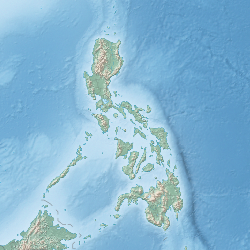Manila Bay
| Manila Bay | |
|---|---|
 Manila Bay at sunset | |
Location in Luzon | |
| Location | Luzon, Philippines |
| Coordinates | 14°31′00″N 120°46′00″E / 14.51667°N 120.76667°E |
| Type | bay |
| River sources |
|
| Max. length | 19 km (12 mi) |
| Max. width | 48 km (30 mi) |
| Surface area | 2,000 km2 (770 sq mi) |
| Islands | |
| Settlements |
|

Manila Bay is a natural harbor that serves the Port of Manila (on Luzon), in the Philippines. Strategically located around the capital city of the Philippines, Manila Bay facilitates commerce and trade between the Philippines and its neighboring countries.[4] It is effectively the gateway for the country's socio-economic development that began in ancient times.
Geography
[change | change source]Manila Bay has an area of 1,994 km2 (769.9 sq mi), and a coastline of 190 km (118.1 mi). It is situated in the western part of Luzon island, and is bounded on the east by and Metro Manila and the province of Cavite; on the north by the provinces of Bulacan and Pampanga; and on the west and northwest by Bataan province.[5] Manila Bay drains approximately 17,000 km2 (6,563.7 sq mi) of watershed area, with the Pampanga River contributing about 49% of the freshwater influx.
With an average depth of 17 m (55.8 ft), it is estimated to have a total volume of 28.9 billion cubic meters (28.9 cubic km). Passage into Manila Bay is 19 km (11.8 mi) wide and expands to a width of 48 km (29.8 mi). This varies sometimes from 22 km (13.7 mi) at its mouth and expands to 60 km (37.3 mi) at its widest point.[5]
The islands of Corregidor and Caballo divide the Bay's entrance into two channels,[5] about 2 mi (3.2 km) towards the North and 6.5 mi (10.5 km) wide on the South side.
The municipality of Mariveles in the northside province of Bataan, is an "anchorage" at the Bay's northern entrance. On either side of the bay are volcanic peaks topped with tropical foliage: 40 km to the north is the Bataan Peninsula and to the south is the province of Cavite.
Local and international ports in the bay's North and South harbors facilitate much of the country's maritime activities.[4] The North Harbor, being smaller, is used for inter-island shipping, while the larger South Harbor is used for ocean-going vessels.[5]
Land conversion
[change | change source]The land conversion of mangrove and mudflat areas into fishponds impacted the physical features of the bay, such that what was an irregular shoreline in 1944 became linear in 1977.[5] Shoreline retreat continued as man-made structures such as fish pens occupied the coastal areas, with "progradation" being dominant from 1977 to 1991. Most areas of the bay, other than those near the harbors were fishing grounds, with fisheries and aquaculture as the dominant livelihood for the coastal inhabitants.[5]
From 1990, approximately 1,200 hectares of mangroves were cleared, with the land converted for aquaculture or used as salt beds.[6] In 1993 much of the fisheries resources steadily declined due to overfishing and overharvesting.
Beach nourishment
[change | change source]In the early September 2020, rehabilitation work began on Manila Bay Beach, through the process of "beach nourishment", a common practice in the creation of beaches around the world. However, the program[7] came under criticism by heritage conservationists and environmentalists for the use of crushed dolomite for beachfront nourishment.[8][9] Rehabilitation activities continued despite the criticism, as the Bay's seawater quality significantly improved, especially pronounced along the shoreline. The country's Department of Environment and Natural Resources reported a significant drop of fecal coliform level in the waters around the beach, from 2.2 million mpn/100ml last January 4, 2021 to 523,000 mpn/100 ml in February 2021, based on the average count from three monitoring stations.[10][11]
References
[change | change source]- ↑ "Tripa De Gallina". Philippine News Agency.
- ↑ "Category: Carabao Island-Fort Frank". PhilippineSailer.net.
- ↑ "Post- Fort Drum, Philippines". ArmyHistory.org.
- ↑ 4.0 4.1 Jacinto, G.S., Azanza, R.V., Velasquez, I.B. and Siringan, F.P.(2006)."Manila Bay:Environmental Challenges and Opportunities" in Wolanski, E.(ed.) The Environment in Asia Pacific Harbours. Springer: Dordrecht, Netherlands. p309-328.
- ↑ 5.0 5.1 5.2 5.3 5.4 5.5 Jacinto, G.S., Velasquez, I.B., San Diego-McGlone, M.L., Villanoy, C.L. and Siringan, F.B.(2006)."Biophysical Environment of Manila Bay - Then and Now", in Wolanski, E.(ed.)The Environment in Asia Pacific Harbours. Springer: Dordrecht, Netherlands. p. 293-307.
- ↑ PEMSEA. (2004) Manila Bay: Refined Risk Assessment. PEMSEA Technical Information Report No. 2004/01. Global Environment Facility / United Nations Development Programme / International Maritime Organization Regional Programme on Building Partnerships in Environmental Management for the Seas of East Asia (PEMSEA). Quezon City, Philippines.
- ↑ "Impact of the Use of Dolomite in Beach Nourishment in Manila Bay". BusinessMirror. November 2, 2020. Retrieved December 11, 2020.
- ↑ Perez-Rubio, Bella (September 7, 2020). "Palace: P389-M Manila Bay 'white sand' project approved prior to pandemic". The Philippine Star. Retrieved September 19, 2020.
- ↑ Sabillo, Kristine (September 8, 2020). "Manila Bay sands project violates National Cultural Heritage Act, other laws - environmental groups". ABS-CBN News. Retrieved September 19, 2020.
- ↑ Yumol, David Tristan (February 18, 2021). "DENR records significant drop in Manila Bay's coliform level". CNN Philippines. Archived from the original on February 19, 2021. Retrieved April 8, 2021.
- ↑ "DENR records further decrease in Manila Bay coliform level". Philippine News Agency. February 18, 2021. Retrieved April 8, 2021.



